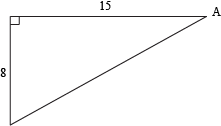Sin, Cos, Tan
We've had our fun with triangles and legs, Pythagoras and his invention, and exponents and square roots. But seriously, that stuff isn't at the core of trig.
Real trig rocks to the tune of sine, cosine, and tangent.

Say what?
The three basic trigonometric ratios are sine, cosine, and tangent.
Stay with us. We aren't speaking in a differently language (unless you consider Latin to be a different language).
Their abbreviations/nicknames are sin, cos, and tan. A good way to remember their definitions is this weird acronym:
SOHCAHTOA
Let's see how this guy works with a right triangle:

SOH stands for Sine equals the Opposite side over the Hypotenuse:

CAH stands for Cosine equals the Adjacent side over the Hypotenuse:

TOH stands for Tangent equals the Opposite side over the Adjacent side:

Here's an important little factoid: these ratios only work with right triangles. If there's not a right angle in your triangle, all bets are off.
Sample Problem
If a = 8 and b = 15 in the following right triangle, find the sine, cosine, and tangent of angle A.

First, use a2 + b2 = c2 to find c, the hypotenuse.
c2 = 82 + 152
c2 = 64 + 225
c2 = 289
c = 17
Now let's plug c = 17 into our relationships (oh no, not those again) for sin, cos, and tan.

Sample Problem
In the following triangle, find the sine, cosine, and tangent of angle B.

If the B is throwing you for a loop, don't worry. You still apply the ratios the same way. Sine is still opposite side over hypotenuse, and so on.
But first, we need that missing leg. We know the other leg and the hypotenuse, so we can use Pythagoras to find a.
a2 = c2 – b2
a2 = 292 – 202
a2 = 841 – 400
a2 = 441
a = 21
In relation to angle B, 20 is the opposite side, 21 is the adjacent side, and 29 is the hypotenuse. Throw those into the trig ratios and we're done.

Sample Problem

What are the sine, cosine, and tangent of angle A?
First find c.
c2 = 12 + 12
c2 = 1 + 1
c2 = 2
Now just take the square root of both sides.


Finishing move: apply the trig ratios.
Hint: Don't forget to rationalize your denominators. In other words, make sure there aren't any radical signs on the bottoms of your fractions. For a refresher on this little calculation, go here.


